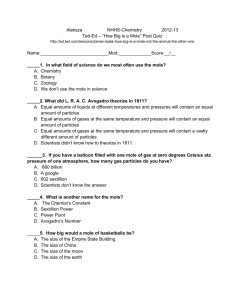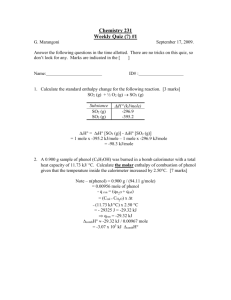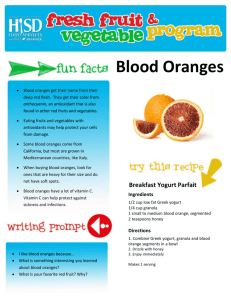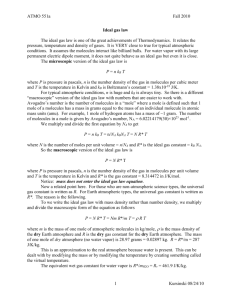1 Mole of Oranges
advertisement
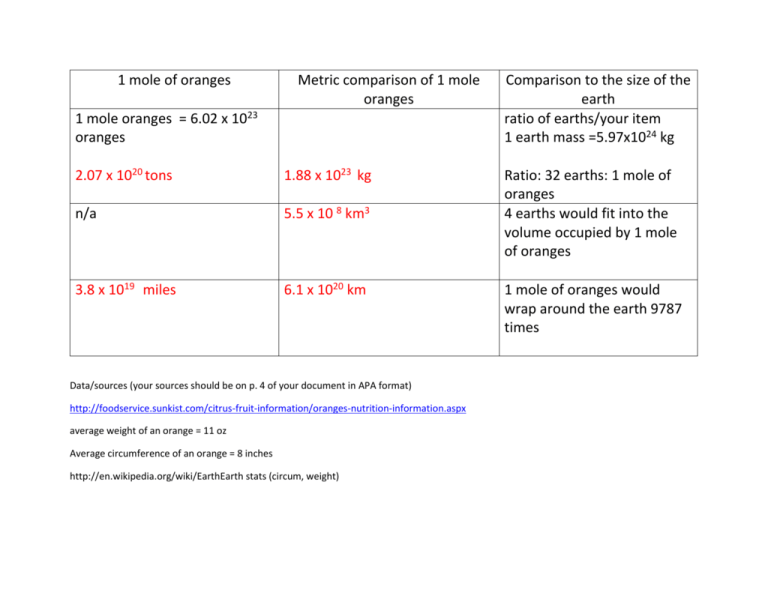
1 mole of oranges Metric comparison of 1 mole oranges 1 mole oranges = 6.02 x 1023 oranges 2.07 x 1020 tons 1.88 x 1023 kg n/a 5.5 x 10 8 km3 3.8 x 1019 miles 6.1 x 1020 km Data/sources (your sources should be on p. 4 of your document in APA format) http://foodservice.sunkist.com/citrus-fruit-information/oranges-nutrition-information.aspx average weight of an orange = 11 oz Average circumference of an orange = 8 inches http://en.wikipedia.org/wiki/EarthEarth stats (circum, weight) Comparison to the size of the earth ratio of earths/your item 1 earth mass =5.97x1024 kg Ratio: 32 earths: 1 mole of oranges 4 earths would fit into the volume occupied by 1 mole of oranges 1 mole of oranges would wrap around the earth 9787 times Calculations: Finding the mass of 1 mole of oranges: 6.02 x 1023 oranges x 11 oz/orange x 1 lb/16 oz x 1 ton/2000 lbs = 2.07 x 1020 tons Convert this to kg: 2.1 x 1020 tons x 2000 lb/1 ton x 1 kg/2.2046 lb = 1.9 x 1023 kg Finding the volume of 1 mole of oranges (Note: if your object does not lend itself readily to the calculation of volume don't do it. Just be sure to include why you did not calculate it in your paper). Use the formula for finding the volume of a sphere to estimate volume of an orange: 4/3π r3 = 4/3(3.14)(4 in)3 =268 in3 (Assuming radius of orange=4 in). Convert this to m3 or L: 6.02x10^23 oranges x 268 in3 /orange x (1 ft/12 in)3 x 28.32L/1 ft3 = 2.6 x 10^24 L (Note: see wb p.4 for conversion factors) Finding the length of 1 mole of oranges in miles when placed next to each other: 6.02x10^23 oranges x 8 in/orange x 1 ft/12 in x 1 mile/5280 ft = 7.6x10^19 miles convert this to km: 7.6x10^19 mi x 1.609 km/1 mi = 1.2x10^20 km Now compare to the size of the earth (or whatever big object you choose). Mass: take mass of earth (in kg) and divide by mass of 1 mole (in kg) of your object. This ratio tells you how many earths it would take to equal the mass of 1 mole of your object Volume: take volume of the earth (m3 or L) and divide it by the volume of 1 mole (in m^3 or L) of your object. This ratio tells you how many earths would fit into the volume of 1 mole of your object Length: this is where you can get creative. Compare the length of 1 mole of your object (using miles or km) to the circumference of the earth or distance to the sun or a star, or the distance from Kaysville to some other country. An example would be: you would have to walk around the equator 10,000 times to equal the length of 1 mole of oranges (this is an estimate). For the writing part: Introductory paragraph -explain what this project is about (to understand the size of a mole), why you chose the object you did for your mole calculations; explain what you chose to compare it to. Body of the paper- 1 large or 2 smaller paragraphs-explain what you learned from doing the calculations and the comparisons made with a large object; you should include some numbers from your comparisons. Conclusion-1 paragraph- explain your understanding of the concept of a mole gained by doing this project. Term Project is found on p. 13 in the purple workbook. Due date: Oct. 22 (or Oct. 14 for extra credit) Paper includes 4 pages: 1) a cover page containing your name, period, name of project), 2) an essay with introductory paragraph followed by a discussion of your results and what you learned (please use APA format), 3) a table showing your results, and 4) Source citations (in APA format, type the sources of information you used in your comparisons). Use APA format throughout your paper.



